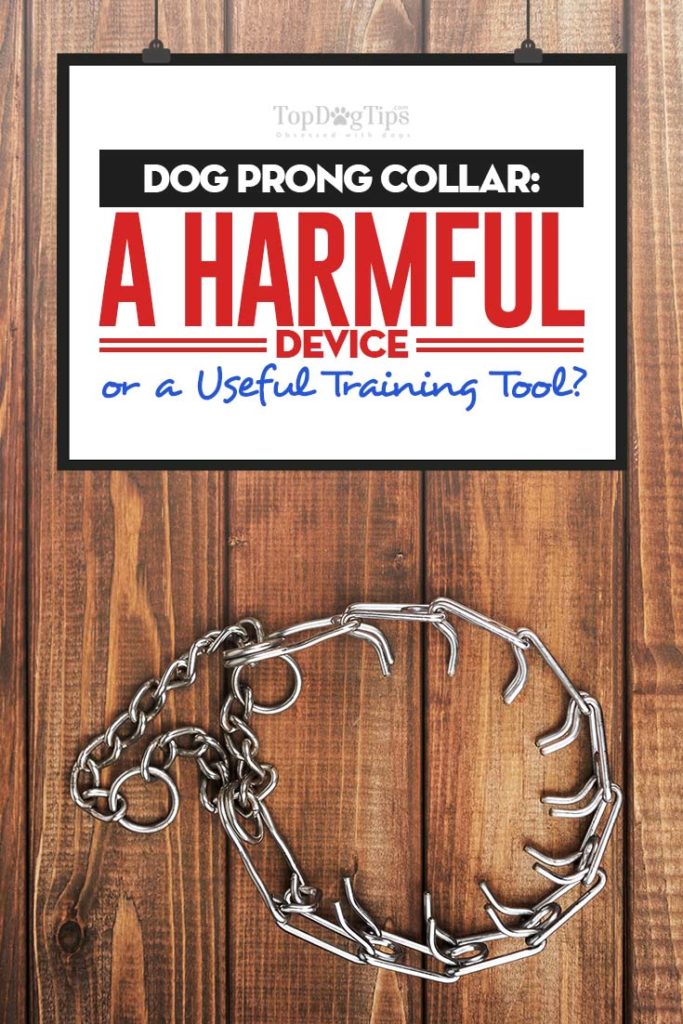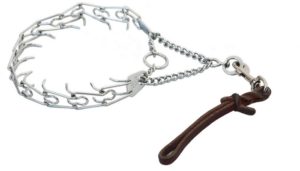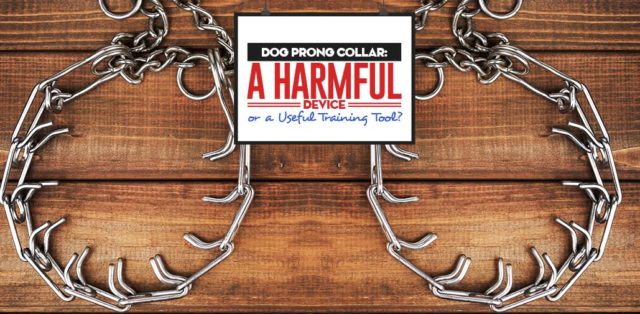
Table of Contents
In this article, we are going to touch on one of the more controversial topics among dog owners, trainers, and other experts in the pet industry—the dog prong collar.
A torture device for a lot of people, prong collars for dogs are not that divisive among professional dog trainers.
Qualified professionals will be quick to point out a lot of the misconceptions about the dog prong collar.
Dog prong collars, sometimes referred to as pinch collars for dogs or choke collars for dogs, are a training tool.
If you don't know what prong collars for dogs are or you've never had experience with one, they are collars made with interlocking links.
These links each have two prongs on the end that pinch the dog's neck when the collar is tightened.
This is what a dog prong collar looks like:
According to proponents of dog prong collars, who often happen to be professional dog trainers, while the design may sound painful when these collars are used the way they are intended, the dog will only receive a slight pinch when the collar is tightened as a corrective measure.
When used properly, no pressure is put on the dog's throat.
“I have never once seen a dog injured from proper use of a prong,” writes Steve Walter, dog trainer and founder of NitroCanine.com. “At most, sometimes I’ll see dogs with sensitive skin, in which case we might use rubber tips on the prong, or put a bandanna between the collar and the neck.“
Many other trainers agree with Steve here and the safe, proper use of prong collars for dogs.
So, let's take a closer look at the correct and humane way of using dog prong collars for training dogs and what you need to know before purchasing one.
EXPERT INTERVIEW: How to Safely Train Dogs with Electronic Shock Collars?
Dog Prong Collar: Should You Use It?
Are Dog Prong Collars Inhumane?
The short answer to that question is “no,” with an added caveat “when used properly.”
And if I were to expand a bit more on the matter, I'd say that they aren’t any more inhumane than many other dog accessories —a simple leather dog collar can choke and hurt your dog if you are using it incorrectly, and the same goes for a dog prong collar.
Is it possible that a pinch dog collar will hurt your pet? Yes.
Can a prong collar cause your dog some serious physical damage? Yes.
Is this what dog prong collars are designed to do, and is this what they do when they are fitted and used properly? Absolutely not.
A well-made and well-fitted dog prong collar is guaranteed not to cause any pain to your dog and only to cause him small discomfort when he misbehaves.
When a canine prong collar causes pain and harm to a dog, it is the dog handler’s fault and not the collar’s.
A properly used prong collar for dogs works by simply giving your pet soft, yet noticeable signals of what to do and what not to.
If you train your dog properly, it will even be happy whenever it sees the prong collar coming its way.
There are plenty of other canine training devices, supplies, and tools that have a far less mean-looking design yet can harm your dog more or cause the dog more discomfort.
Dog muzzles can be part of that argument, yet people continue to use them, as well as many other types of collars, such as head collars for dogs.
“Head collars are the worst type of training collars I’ve ever seen,” writes Jeff Gellman, dog trainer and founder of SolidK9Training.com. “The leash is attached to the jaw, which is a highly sensitive area, and a strong pull practically guarantees a cervical injury.”
Going back to prong collars, when a professional dog trainer uses a dog prong collar in the right ways, it is perfect for various different types of dog training methods, including:
- training against leash-pulling
- obedience training
- training against barking at and chasing other animals
- training of deaf dogs
- training of adult dogs that have developed unhealthy habits due to a bad upbringing
Now, on the other spectrum, there are professionals who strictly oppose any type of dog training tool that may seem to harm a dog.
For example, in this article on VetStreet.com, veterinarian Dr Patty Khuly, VMD, lays out some of her good arguments against the use of dog choke collars, which I recommend you peruse before deciding.
While I have to agree with some of her arguments, most (if not all) of them can only be applied to the misuse of dog-prong collars.
None of those things mentioned should result from the proper use of pinch collars on dogs. To better explain this, here's a great explanation from Julia Maclachlan of Doberman Rescue Unlimited:
“The prong collar is often referred to as the “hearing aid” collar: a dog properly introduced to it in the hands of a person likewise prepared suddenly understands the expectations upon him.”
Ultimately, it will be up to you to decide whether a dog prong collar is a human training tool or a harmful device. Similar to shock training collars, these will always remain a controversial tool for training dogs.
But before you lean towards either side, I suggest you read arguments and data from both sides and make a rational decision on what you think is most beneficial not only for you as a trainer but for the health of your dog.
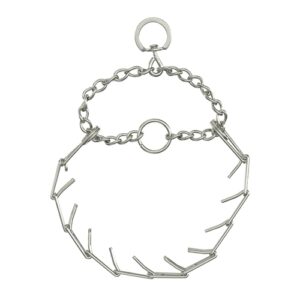 As the closing argument on whether dog prong collars, choke collars, and pinch collars are inhumane or not, I want to mention that most professionals agree that they're a great tool, and people who have not used them will usually label them as harmful.
As the closing argument on whether dog prong collars, choke collars, and pinch collars are inhumane or not, I want to mention that most professionals agree that they're a great tool, and people who have not used them will usually label them as harmful.
And only one aspect of the use of prong collars for dogs that some professional trainers are divided on is how well-suited these collars are for very aggressive dogs when owners take the matters of training dogs into their own hands with the use of a professional's help.
Some argue they are a perfect fit for aggressive canines, while others say that even though it's counter-intuitive, a dog prong collar is actually not to be used on overly aggressive dogs unless you have professional experience with training aggressive dogs.
The reason is that such aggressive dogs are usually well beyond what a prong collar can do for them, and they will only see it as further irritation, complicating the process.
Generally, it's best to leave the training of aggressive dogs to the professionals.
Whether the best approach is to do that with or without dog prong collars, it's up to the dog trainer to assess and then discuss this without before deciding on the training methodology.
If you feel that a punch dog collar may be right for your pet, you may want to discuss this choice with a professional dog trainer before actually using one for your pet.
RELATED: Respect Your Fido – Humane Dog Training Equipment
How Does a Dog Prong Collar Work?
Dog prong collars work on a very simple principle—simulating a mother’s bite on the neck.
Yes, “bite” may sound harmful, but it isn’t when a mom does it to a pup, and it is something all mothering dogs do.
Whenever a pup does something it’s not supposed to do, the mother comes and gently bites its neck to signal the problem.
Getting gently and softly bitten on the neck is one of the oldest and most ingrained instincts in dogs.
A dog prong collar is designed to tell the dog that what he's just done is not right.
However, to do it properly, two things must be ensured first:
1. Ensure the dog prong collar fits properly
Pick a dog prong collar of the right size for your canine and then place it in the correct manner on the dog’s neck.
A prong collar should be neither too tight around a dog’s neck, because this will cause it instant discomfort, but it should also not be too loose.
A loose prong collar is not only ineffective, but it can also be more harmful to your pooch.
Leerburg.com, a professional dog training website, has a great article on how to fit these prong collars onto your dog and do so correctly. Make sure you familiarize yourself with it.
The bottom line is that when the prongs are loose and have more freedom around your dog’s neck, they are out of your control.
The dog prong collar should fit perfectly on the neck, with each prong being nicely and safely fit in the dog’s fur—without moving among the fur, but without biting the flesh either.
Keep in mind that all dog prong collars loosen by themselves with time.
That’s why it’s important not just to check them out after a while, but to also use them in conjunction with another collar.
This way, even if you forget to check the dog prong collar and it has loosened up enough to slip over your dog’s head, you still won’t lose control of your pet.
2. Use the dog prong collar correctly
A canine prong collar should also be used properly.
I will go more in-depth on that later, but to put it simply, in order to properly simulate a mother’s soft bites, you should pull and operate the prong collar softly and gently, preferably in conjunction with verbal commands and other dog training methods.
Violently pulling the leash and the choke collar will, of course, cause the prongs to bite deep into your dog’s neck and cause harm, so it goes without saying—do not do that.
If you are not feeling confident about how exactly to put on and use the training prong collar on your dog, it's best to consult with a professional dog trainer first and possibly even take a class on dog training so you can proceed on your own after that.
Here's a good video that will get you started:
How to Properly Use a Dog Prong Collar
Now, the interesting part.
Understanding how to use a dog prong collar with your Fido is very important for a couple of reasons.
First, you do not want to cause your dog any pain. As previously stated, when used incorrectly, the prongs can harm your dog.
In order for the training to be successful, as I have mentioned above, the prongs of a collar are designed to simulate a mother’s gentle bite.
This means that you shouldn’t just learn how gently to pull the collar; it means that you should understand exactly what relationship you want to build between yourself and your dog while you’re training.
If the training is to be successful, the dog must understand that you are the authority figure while in the process of training. You are the one making the decisions at the moment, and you are the one that can handle any problem.
The dog needs to trust that you are in charge; otherwise, it will have the urge to act on its own accord.
If, for example, a dog is anxious around other dogs, in order to lose this anxiety, it must believe that you are in charge and, therefore, the other dogs are not a problem.
To achieve that goal, you need to couple the use of the pinch dog collar with the right verbal cues, hand gestures, and practical decisions.
Additionally, this is precisely why dog prong collars are not a good choice for an aggressive dog when you do not have any experience and are unsure how to handle these situations.
These dogs feel like they are/should be the “Alpha” in your relationship and don’t respond to “motherly bites on the neck,” regardless of how soft they are.
RELATED: 10 Best Dog Training Collars Safe for Dogs
Now, let's talk about the specific steps and things you'll need to know when training with a dog prong collar:
1. Introduce the prong collar
You'll need to introduce your dog to the collar before beginning any training. This is an often underestimated step.
A lot of dog owners just go to their dog and put the new collar around its neck.
This is a mistake, not so much because of the prongs on the collar as much as the fact that the collar is new to your pet.
Just think of how awkward and uneasy you feel whenever you put on some new variation of an otherwise familiar accessory—a new watch, new earbuds, new glasses, new shoes, etc.
It is new, it is unfamiliar, and it can be very annoying, especially when you are a dog and have no clue why it is happening.
So, the first step is to introduce your dog to the choke collar properly. Show your dog that it is nothing to be scared of and nothing to pay attention to.
Take your dog someplace familiar, maybe to its favorite place in the park. This way, he will feel secure and comfortable.
Now, bring out the tasty treats! Show your dog the collar (don’t immediately put it on!), and as he sees it, give him a treat, pet him gently, and say something nice and upbeat that the dog will recognize.
Repeat this process several times until you are certain that the dog has absolutely zero ill feelings towards the collar and instead associates it with the comfort of the park, the tastiness of the treats, and your complete and unconditional love.
RECOMMENDED: Dog Shock Collar Controversy – What Do the Experts Say?
2. Put on the prong collar
Once you are certain that your dog views the prong collar as its new and unfamiliar, but yet absolutely favorite new friend, it’s time to put it on.
If your dog doesn’t feel too fondly about the new accessory yet, return to step one and keep at it—the prong collar works by giving physical commands to your dog, so you have to make sure that your dog is ready to accept commands from this new device.
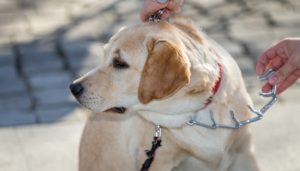 Now, it’s time to not just show the pinch collar to your dog but to actually put it on. If you’ve aced the first step, this shouldn’t be an issue.
Now, it’s time to not just show the pinch collar to your dog but to actually put it on. If you’ve aced the first step, this shouldn’t be an issue.
Sure, the dog may try to shake the collar off or scratch at it at first, but as long as this is just instinctive behavior and not a sign of irritation, you are good to go.
Try taking the collar off and putting it back on several more times. Keep giving your furry friend those tasty treats and petting it on the head (yes, this first day may not be very dietary, but it’s only for today, so that’s ok).
Once both you and your dog are comfortable with the process, it’s time to actually fit the collar to your dog’s neck.
3. Get the right fit
Since this is the first time you’re putting the choke collar on, it will be too loose. What you’ll need to do is take some of the prongs off.
If you’ve consulted with a specialist or you’ve watched some of the many video tutorials like the one we showed you, you should know how to do that.
And, if the previous two steps of the process were done well enough, your dog should also be perfectly fine with what’s happening.
Remember, the prong collar should fit snugly around your dog’s neck—just behind the ears and the jaw.
It shouldn’t be too tight, in order not to cause any physical discomfort to your pet, but it should be tight enough as to not move around—a prong collar that’s too loose can cause as much damage (if not more) as an overly tight collar, since the prongs can move around, get stuck to each other and deal some nasty harm.
SIMILAR: How No-Pull Dog Harnesses and Collars Help with Dog Leash Pulling
4. When to use dog prong collars
Now that the dog knows that the prong collar is nothing to fear and that you are comfortable putting it on and taking it off with ease, it’s time to talk about how and when actually to use the prong collar.
One of the main problems a lot of new dog owners face with prong collars is that the dog starts to behave when the collar is on, but it continues to misbehave once the collar is removed.
To fix that, dog owners keep putting the pinch collar back on and resume training immediately. And here is the mistake: the reason this happens is because the dog associates the training with the collar.
Whenever the dog receives physical commands through the prong collar, it realizes that it is the prong collar that’s giving the command.
The dog’s still fine with it, because it associates the collar with treats and other good stuff, but it also understands that behaving should be done only when the collar is on, which isn’t our goal.
What you need to do is to disassociate the prong collar from the training. To do that, simply put the prong collar on 20-30 minutes before the training starts and take it off 20-30 minutes after the training is complete.
Also, for the first few days, keep putting the collar on and off at different times during the day and do the behavioral training you have in mind at different times as well.
This way, your dog will still be fine with the collar since it will associate it with your treats and love, but it won’t associate it with the training itself.
Fido should soon start behaving all the time, regardless of whether the collar is on or not.
5. It's time to train
What about the training itself? Don’t worry, we haven’t forgotten about that. There are a lot of different types of dog training that all depend on what exactly you want to train your dog to do and not to do.
Each of them is deserving of a separate article, but as far as the collar is concerned, there is one key principle that must always be followed:
If you want the dog to trust you and view you as a good leader, you need to act like a good leader.
Does this sound too complicated? After all, we’re taught that great leaders are a special breed of people who are very rare to come by!
Well, don’t worry—being a leader to a dog is not as difficult as being a leader to a nation.
All you need to make sure is that the communication between you and the dog—particularly the communication via the prong collar —is well-timed and clear.
Don’t use the prong collar to punish your dog; use it simply to let him know that he shouldn't be doing that.
Your dog shouldn’t feel terrorized by the pinch collar. He shouldn’t feel powerless and completely subordinate to your every whim.
He should be free to do everything he usually does and only get a brief and gentle warning whenever he does something undesirable.
If you do this correctly and couple it with the positive reinforcement of treats and petting whenever the dog does what it should do, every type of dog training will be done exceptionally quickly and easily. Before you know it, the dog prong collar won’t be needed anymore.
READ NEXT: Shock Collars for Dogs – 5 Things You MUST Know Before Buying A Shock Collar
